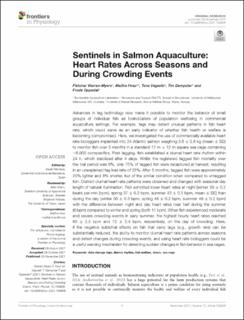| dc.description.abstract | Advances in tag technology now make it possible to monitor the behavior of small groups of individual fish as bioindicators of population wellbeing in commercial aquaculture settings. For example, tags may detect unusual patterns in fish heart rate, which could serve as an early indicator of whether fish health or welfare is becoming compromised. Here, we investigated the use of commercially available heart rate biologgers implanted into 24 Atlantic salmon weighing 3.6 ± 0.8 kg (mean ± SD) to monitor fish over 5 months in a standard 12 m × 12 m square sea cage containing ∼6,000 conspecifics. Post tagging, fish established a diurnal heart rate rhythm within 24 h, which stabilized after 4 days. Whilst the registered tagged fish mortality over the trial period was 0%, only 75% of tagged fish were recaptured at harvest, resulting in an unexplained tag loss rate of 25%. After 5 months, tagged fish were approximately 20% lighter and 8% shorter, but of the similar condition when compared to untagged fish. Distinct diurnal heart rate patterns were observed and changed with seasonal day length of natural illumination. Fish exhibited lower heart rates at night [winter 39 ± 0.2 beats per min (bpm), spring 37 ± 0.2 bpm, summer 43 ± 0.3 bpm, mean ± SE] than during the day (winter 50 ± 0.3 bpm, spring 48 ± 0.2 bpm, summer 49 ± 0.2 bpm) with the difference between night and day heart rates near half during the summer (6 bpm) compared to winter and spring (both 11 bpm). When fish experienced moderate and severe crowding events in early summer, the highest hourly heart rates reached 60 ± 2.5 bpm and 72 ± 2.4 bpm, respectively, on the day of crowding. Here, if the negative sublethal effects on fish that carry tags (e.g., growth rate) can be substantially reduced, the ability to monitor diurnal heart rate patterns across seasons and detect changes during crowding events, and using heart rate biologgers could be a useful warning mechanism for detecting sudden changes in fish behavior in sea cages. | |
